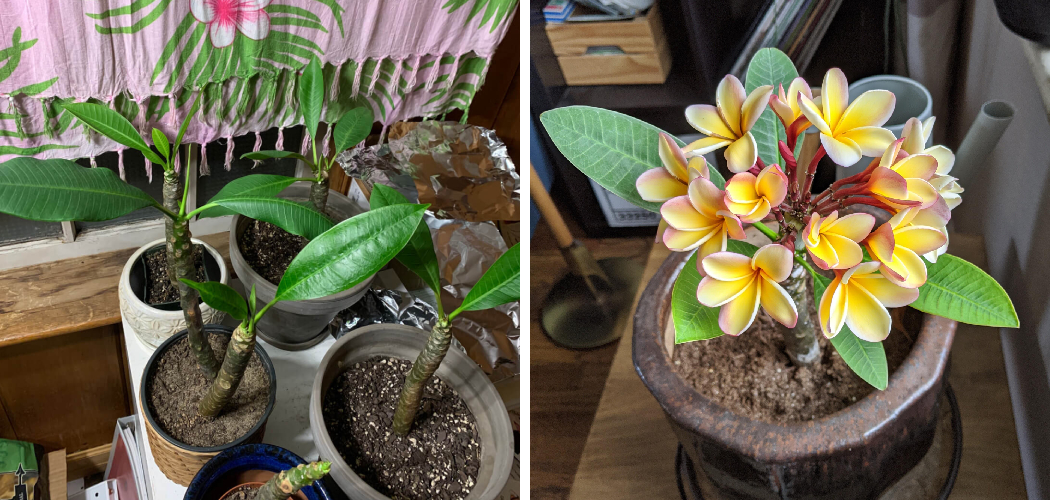To bring plumeria out of dormancy, gradually increase watering and move it to a warm location with sunlight. Plumeria plants, also known as frangipani, are tropical beauties that go dormant during the winter months.
When spring arrives, it’s time to awaken your plumeria and bring it back to life. The key to bringing plumeria out of dormancy is to follow a few simple steps. We will guide you on how to bring your plumeria plant out of dormancy and ensure its healthy growth throughout the season.
By gradually increasing watering and providing ample sunlight, you can wake up your plumeria and enjoy its vibrant blooms once again. Keep reading to learn the steps required to revive your plumeria and make it thrive all summer long.

Understanding Plumeria Dormancy
Plumeria dormancy is a natural phase in the plant’s growth cycle, characterized by a period of rest and minimal growth. Understanding the factors that influence dormancy is essential for bringing plumeria out of this state. Temperature, light, water, and nutrition all play a role in the dormancy cycle.
Cold weather and reduced sunlight trigger dormancy, while warmer temperatures and increased light promote growth. Similarly, watering and fertilization should be adjusted to match the plant’s needs during dormancy. Signs of plumeria dormancy include a cessation of leaf production and the shedding of existing leaves.
By carefully monitoring the plant’s environment and providing the necessary conditions, plumeria can be encouraged to come out of dormancy and resume active growth and blooming.
How to Bring Plumeria Out of Dormancy: Step by Step Guide
Preparing Plumeria For Dormancy
Preparing your Plumeria for dormancy involves considering the timing and climate conditions to ensure their well-being. To bring them out of dormancy, reduce watering and fertilizer gradually.
Waking Up Plumeria From Dormancy
Plumeria dormancy can be broken by closely monitoring temperature and daylight patterns. Regular check-ups will help ensure that the plant receives the right conditions for waking up. It is also essential to adjust watering and feeding techniques accordingly. During dormancy, reduce watering frequency to prevent the roots from rotting.
However, as the plant begins to come out of dormancy, gradually increase the watering to encourage growth. Similarly, modify the feeding schedule by providing a balanced fertilizer mix, rich in phosphorus, to promote blooming. Remember to refrain from overcrowding the pot with excessive foliage as it may hinder growth.
By adhering to these guidelines, you can effectively bring your plumeria out of dormancy and witness its beautiful blooms.
Troubleshooting Dormant Plumeria
Bringing plumeria out of dormancy can be a challenge, but with proper troubleshooting, you can identify and address common issues. One important aspect is addressing pest infestations, such as spider mites or aphids, which can hinder growth. Regular inspections and applying appropriate insecticides can help eliminate these pests.
Similarly, diseases like root rot or rust can affect plumeria during dormancy. Ensuring proper drainage and avoiding overwatering can prevent root rot, while applying fungicides can control rust. Additionally, observing leaf discoloration or wilting can indicate a nutrient deficiency. Providing balanced fertilizer, with the right amount of nitrogen, phosphorus, and potassium, can rectify this issue.
By understanding these common dormancy problems and taking appropriate actions, you can successfully bring your plumeria out of dormancy and promote healthy growth.
Extending Plumeria’s Blooming Period
To extend the blooming period of your Plumeria, there are several strategies you can follow. Firstly, regular pruning is crucial to promote new growth and encourage flowering. Remove any dead or damaged branches, and trim back the tops of the stems to stimulate lateral growth.
Secondly, ensure that your Plumeria receives ample sunlight, as this is vital for its blooming cycle. A minimum of six hours of direct sunlight is recommended. Additionally, proper fertilization is essential. Use a balanced fertilizer high in phosphorus to encourage flower production.
Remember to water your Plumeria consistently, providing enough moisture without causing waterlogging. Lastly, be patient and maintain a regular care routine. With proper attention and a well-balanced approach, you can enjoy a prolonged blooming period for your Plumeria.
Frequently Asked Questions On How To Bring Plumeria Out Of Dormancy
When Should I Bring My Plumeria Out Of Dormancy?
Bring your plumeria out of dormancy in early spring after the last frost.
Do You Water Plumeria When Dormant?
Watering plumeria when dormant is not necessary as they are in a resting state.
How Do I Bring My Plumeria Back To Life?
Revive your plumeria by following these steps: provide optimal sun and water, check for pests, trim dead branches, and fertilize regularly.
How Do You Wake Up Dormant Plants?
To wake up dormant plants, provide them with adequate sunlight, water, and nutrients.
Conclusion
Bringing Plumeria out of dormancy requires a combination of patience, proper care, and attention to detail. By following the steps outlined in this blog post, you can ensure that your Plumeria plants wake up from their dormant state and thrive once again.
Remember to start by slowly introducing light and water, gradually increasing the amounts over time. Pruning and fertilizing are also essential for promoting healthy growth. It is important to monitor the plants closely for any signs of pests or diseases and to take appropriate action if necessary.
By providing the right environment and following these guidelines, you will be rewarded with a stunning display of vibrant Plumeria blooms. So go ahead and revitalize your dormant Plumeria plants and cherish their beauty and fragrance throughout the year. Happy gardening!

